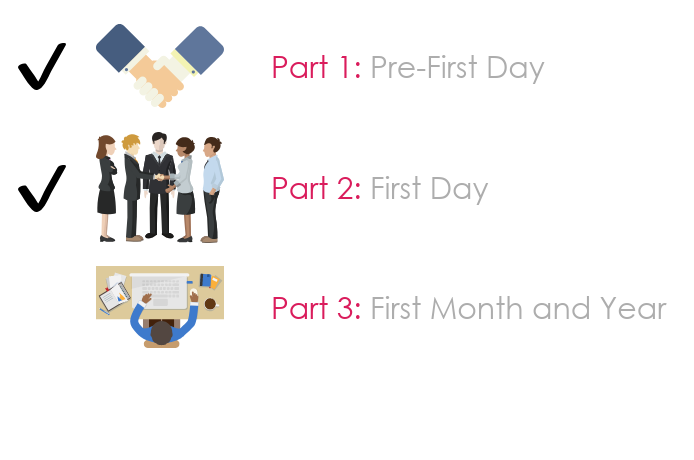“People will forget what you said. People will forget what you did. But people will never forget how you made them feel.” – Maya Angelou
Welcome to Part 2 of our ‘Onboarding Best Practices’ series. In Part 1 we reviewed some tips and tricks on how to prepare for your new hire before they even start their first day on the job.
Part 1: Onboarding Best Practices (Pre-First Day): https://upskillconsulting.ca/2018/06/05/part-1-onboarding/
Onboarding is an integral component of the employee life cycle. You’ve hired top talent, but the next step of onboarding is just as crucial. Welcoming your new hire and providing them with a memorable and valuable experience on the onset of their journey with you will help guide them in what to expect and what is expected of them.
Onboarding is the process of integrating a new employee within an organization to help them better understand the company, the culture and their role and ultimately sets them up for success as a productive member of the organization and team.
Reflecting back on both my experience as a new hire in organizations and also as a part of the HR team welcoming our new hires, I have picked up a few best practices along the way that were impactful and effective in onboarding new employees from the moment they signed the employment contract to the completion of their first year in their new role.
In Part 2 we will focus on onboarding best practices for your new hire’s first day on the job.
First Day
Introductions to Team, Buddy and Mentor

On the first day, it’s important to help the new hire establish connections with their team, support network and fellow colleagues. This is the new hire’s first opportunity to build relationships with others, allowing for inclusivity and engagement right off the bat.
In past experiences, both as a new hire and an HR Manager welcoming our new hires, when formal introductions were made, the employee integrated faster into the company and within their respective team.
On day one, the introductions are brief but allow for the new hire and existing employees to match faces to the names and jumpstart the working relationship. These key players will be fully involved in the new hire’s onboarding in the coming weeks and months, but first day introductions simply kickstart the connections and social interactions.
In one of my previous roles, I worked on a remote team with members working out of British Columbia, Quebec and Ontario. Since face-to-face introductions weren’t viable, the team used video conference technology to introduce new additions to the broader team in all three locations.
- During the scheduled weekly team meeting, the new hire would be introduced by the direct Manager.
- The new hire had the opportunity to introduce him/herself to the team – sharing some professional and personal tidbits about themselves.
- The team in turn would introduce themselves, explaining their positions within the team/company.
Office Tour
Providing a walk-through of the office facilities is important as it helps familiarize the new hire with their new surroundings. When working as an HR Manager in a public practice accounting firm, the office tour was an important part of our new hire orientation checklist. We would organize an office tour for our group of new hires and one-off new hires, and included the following stops:
- Parking lot (designated parking stalls)
- Meeting room(s)
- Restroom(s)
- Lunch room(s)
- Kitchen
- Coffee/tea station(s)
- Vending machine(s)
- Supply area(s)
- Emergency and first aid area(s)
- Photocopier, fax, and scanners
- Alarm panel(s)
- Mail room
- Gym facility
- Emergency exits
As best practice, I provide the new hire with a printed floor plan. This way the new hire refers to the plan as we tour the facility and jots down notes on the floor plan for future reference.
Training/Onboarding Schedule
To reassure the new hire that they will be supported in their new role in the coming days, weeks and months, provide a copy of the training and onboarding schedule you’ve put together in advance. This demonstrates that as a company, you have prepared for the new hire and have invested the time, energy and resources in setting them up for success.
Reflecting back on personal experience, new hires appreciated having a schedule of what their first week and month would entail. It provided them with a clearer picture of who they’d meet, what they’d do and what they’d learn in the process.
Here are some best practices to consider:
- Provide a print out of the schedule, along with an electronic copy for reference
- Include names/departments/contact information for key stakeholders involved in the onboarding/training schedule
- Incorporate flexibility into the schedule by blocking off “free” time for the new hire to settle in, review materials/work, etc.
Welcome Lunch
The first day on the job can be a stressful one. Taking a new hire out for lunch with their direct Manager and select team members, will begin the engagement process on day one. It provides a casual setting to get to know the new hire and vice versa. One core component of engagement is whether an employee feels like they belong and are a part of a team. Organizing a first day lunch with teammates promotes that sense of belonging and eliminates the stress around making new friends at work.
The lunch invitees should include:
- Direct Manager/Supervisor;
- Mentor and buddy, if applicable;
- Team (potentially entire team or select members); and
- The new hire of course!
Why not provide some options for the new hire to choose where they’d like to eat? Provide a listing of surrounding restaurants and hot spots for lunch. In addition to making them feel a part of the process, you’ve also provided them with useful information on local area lunch spots.
Review Paperwork, Policies and Procedures
The employee/employer relationship has officially begun. It’s important to ensure that all required paperwork has been signed and submitted. This is typically when Human Resources will review paperwork requiring signatures (i.e. Tax forms, direct deposit forms, policy sign offs etc.). Creating a structured checklist of all necessary paperwork is helpful to ensure that no paperwork falls through the cracks during onboarding.
In addition to paperwork, a thorough review of policies, procedures and safety orientation are required. Typically on the first day, this is a high level overview with more in-depth safety training of employee/employer responsibilities during the first week.
Provide Equipment and Tools

To set a new hire up for success, they need to have the proper tools and equipment to fulfill their job responsibilities. Set up their equipment and tools in advance, allowing you to walk the new hire through the following on their first day:
- Logging onto the laptop/computer
- Signing into various programs/software
- Setting up their voicemail/phone system
Review Organization, Culture, Structure
To help the new hire better understand and integrate into the company culture, it’s important to review the company history, its people and shared values. During the interview process, the new hire would have garnered some insight into the company prior to accepting the role, but delving further into the ‘What we do’ and ‘Who we are’ will help the new hire build a more meaningful and aligned connection to the company.
Some best practices to consider:
- Create a welcome video including a review of the organization, its history and its people:
- Incorporate a welcome message from Executives/Leadership
- Include employee interviews/excerpts/first-hand testimonials
- Set aside one-on-one time for the new hire to meet with member(s) of leadership
Allow Time to Settle In

Day one can be overwhelming. The onboarding process goes well beyond day one, so give the new hire time to absorb, review and make sense of information on day one. Give them some time to simply settle into their new role and new surroundings.
The new hire has now been welcomed to their first day on the job. Part 3 will review how to successfully continue the onboarding process into their first month and year.

- Trust First, Feedback Second: Why Connection Comes Before Correction - June 1, 2025
- The Not-So-Fluffy Truth About Connection in Leadership - May 2, 2025
- Small Changes, Big Impact: The Case for Micro Shifts in Leadership - April 7, 2025

